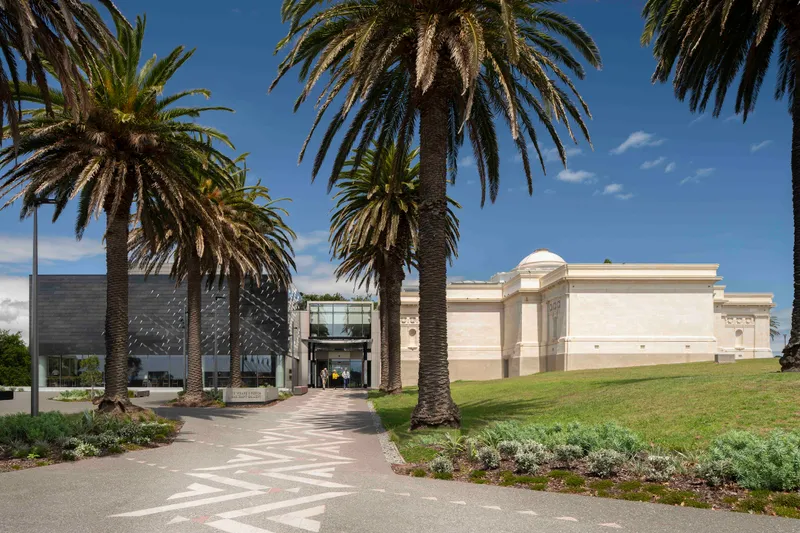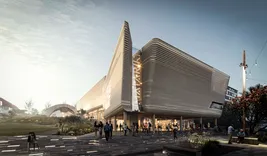A contemporary revitalisation of a city’s cultural centrepiece, future proofed for generations to come
Te Whare o Rehua Sarjeant Gallery

So much poetry in this project. A cultural landmark that holds who we are. The integration of Māori cultural narratives - through form, material, and symbolism - transforms the gallery into a living expression of partnership and place. The most beautiful volume to host the creativity of others, with intricately woven details that tell the story of our past, present and future, holding and restoring its mana.

A building with rich history
The Sarjeant Gallery, as a result of a significant bequest to the city of Whanganui by local landowner and farmer Henry Sarjeant, holds immense historic and architectural value for Whanganui and New Zealand. The category one heritage listed building is built in the shape of a neo-classical Greek cross and is clad in Oamaru stone, once revered as the ‘Rolls Royce of galleries’. Yet, in 2014, the Sarjeant Gallery closed to the public, meeting just 5% of the current new building code and assessed as being a safety risk to staff and visitors and unfit to store the nationally significant collection.
Coupled with Warren and Mahoney’s 1996 success in winning the design competition to forge a landscape architecture project and public funding secured in 2019, Warren and Mahoney embarked on a project to modernise and extend the gallery.

As the creative spirit of New Zealand and Māori art traditions look both to the past and to the future, the new Sarjeant Gallery references its history and its context; the land, the river, and the sea as a continuum, linking our origins and our destinies.



Respectfully expanding and enhancing
A simple, legible floor plan reinforces the architectonic structure of the historic building that respectfully expands and enhances the existing Sarjeant Gallery.
A bridge suspended within the entry foyer connects the new exhibition areas to the existing galleries. The bridge signifies a crossing point between two buildings of distinct architectural styles, while representing a point of departure on a journey into the world of art.
As part of the restoration, the historic Sarjeant building is being seismically strengthened. New structural elements are inserted into the existing building fabric with minimum disruption to the existing interior spaces. The original main entrance and side rooms will be restored and used as a library and members area as well as a ceremonial entrance when required. The existing basement space will be reconfigured to accommodate building services, while on the gallery floor, the prominent dome and skylights remain.
Shaping the future landscape
Situated at the heart of Pukenamu Queens Park, the Sarjeant Gallery stands as a cornerstone, serving as the catalyst for landscape projects in the area. Collaborating seamlessly, Warren and Mahoney's landscape team worked hand in hand with the wider architecture team to craft a unified, integrated landscape design. The scope of the project included a compatible, modern extension that maintains proportions, scale, height, materials and colour.
Recognised as a cornerstone of New Zealand's heritage, its elevated location and views were strikingly connected to local landscape, the Whanganui River and mountains.
Te Pātaka o Tā Te Atawhai Archie John Taiaroa
Reflecting the culture and rich history of Whanganui and mana whenua, the exterior of the new wing, Pātaka o Sir Te Atawhai Archie John Taiaroa tells a uniquely Whanganui story - an expression of the timeless relationship between Te Awa Tupua and mana whenua, signifying a bridge between old and new, past and present.
The black exterior features metal “tioata” shards. Placed at intervals, the tioata have been designed to catch the effect of light shimmering on water. At times this effect can be seen on the Whanganui River and is referred to as kānapanapa.
The kānapanapa concept, including the cultural narrative and designs on the new wing, are informed by Whanganui tribal histories. The phenomenon of light from our river environment is embodied in the architecture and extends the cultural narrative to include the Whanganui community and beyond.
These key design narratives for Te Pātaka o Tā Te Atawhai Archie John Taiaroa were chosen through a series of workshops Warren and Mahoney and Te Kāhui Toi, the artist group appointed by Te Rūnanga o Tūpoho, a collective of hapū from the lower reaches of the Whanganui River. The cultural narrative has informed the design of the facade, tiling for floors, the entry mahau, the waka-bridge, through to the elements of the new identity for Te Whare o Rehua Sarjeant Gallery.
The renovated Te Whare o Rehua Sarjeant Gallery will change Whanganui city in ways that can be budgeted for and evaluated, and in ways that remain unforeseen and unpredictable.


National Geographic’s 20 ‘Best Cultural Spots’
Te Whare o Rehua Sarjeant Gallery was named in the “Best Cultural Spots” list, part of National Geographic’s ‘Best of the World’s Worth a Trip 2024’ category, featuring the top establishments recommended by Nat Geo for the year ahead.
We wanted to give travellers more ideas than ever before to jumpstart their travel planning for 2024 and beyond, so we grew our lists to include curated hotels, restaurants, wellness retreats and cultural spots, like the Sarjeant Gallery, that we believe are worth getting on a plane for.

Collective Effort
Collective Effort




